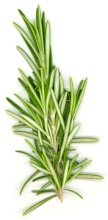

Rosemary

Rosmarinus. (From Latin ros, dew, and Marinus, of the sea, from the maritime habitat.) Labiatae. Two species of evergreen shrubs. Leaves linear, often aromatic. Verticillasters few-flowered, in short axillary racemes; calyx campanulate, 2-lipped, upper lip entire, lower lip 2-lobed; corolla 2-lipped, strongly exserted, upper lip concave, 2-lobed, lower lip 3-lobed, middle lobe spoon shaded; stamens 2, strongly exserted, parallel; style unbranched. Fruit a nutlet. S Europe, N Africa. CultivationRosemary has been an important constituent of herb gardens for centuries, cultivated for the aromatic oils distilled from the flowering shoots and the leaves, used for flavouring meat. Hardy to between -10ºC and 15ºC, but intolerant of excessive winter wet, rosemary makes and attractive evergreen shrub for hot, dry, sheltered positions, particularly on stony, calcareous soils and in milder climates can be grown as informal hedging. Upright forms may be tied in with stout string or wire to create a fastigiate shrub; trailing forms are attractive planted alongside steps or at the top of walls so that the plant will cascade over and down. Rosemary is particularly attractive planted in between paving stones or against a wall. Prune after flowering to maintain a compact and bushy habit. Rosmarinus eriocalyx is seldom cultivated but will make an attractive smaller shrub under glass; it may be cultivated in ordinary loam-based potting compost and will benefit from remaining pot-bound in a clay pot for a number of years. It can be grown in the cool or alpine glasshouse during winter with sparing watering, direct sunlight and good ventilation. Propagate all species from softwood or semi-ripe cuttings in a frame in summer. Rosmarinus eriocalyxFrequently prostrate shrub, rarely erect to 1m, branches grey. Leaves 5-15 x 1-2mm, linear, glabrous and green. Indumentum on peduncle, pedicels and calyx of stellate, and simple glandular hairs. N Africa, S Spain. subspecies tomentosus. Leaves linear, grey-tomentose, indumentum on peduncle, pedicels and calyx densely tomentose. Z8. Rosmarinus officinalisROSEMARY. Variable aromatic species to 2m, with erect, ascending or, rarely, procumbent, spreading brown branches. Leaves 15-40 x 1.2-6mm, linear, coriaceous, green above, white-tomentose beneath, margins revolute, sessile. Peduncle and pedicels tomentose; calyx 3-4mm, expanding to 7mm, green or purple-veined, sparsely tomentose; corolla 10-12mm, pale to dark blue, rarely pink or white. Nutlets brown. Mediterranean. ‘Aureus’: leaves speckled yellow. ‘Albus’: flowers white. ‘Arp’: leaves light green, lemon-scented. ‘Benenden Blue’ (‘Collingwood Ingram’): leaves narrow, dark green. ‘Blue Boy’: dwarf; leaves small. ‘Golden Rain’: leaves lush green, streaked gold. ‘Lockwood de Forest’: procumbent form of ‘Tuscan Blue’. ‘Majorca Pink’: flowers bright pink. ‘Miss Jessop’s Upright’ (‘Erectus’): tall erect. ‘Pinkie’: erect; leaves narrow; flowers bright pink. ‘Prostratus’: stems procumbent. ‘Roseus’: flowers pink. ‘Severn Sea’: spreading, branches arching; flowers deep violet. ‘Tuscan Blue’: leaves narrow; flowers dark blue. Z6.
|
Home
Grow Nuts
Grow Fruit
Grow Vegetables
Cyberian Index
If you like this website and want one of your own contact
Cyberian All information correct at
time of publication and open to updates as necessary. No part of this website,
or its vectors, may be produced in any shape or form, using any type or design
of medium, system, equipment or otherwise without the prior written consensual
notice of the Cyberian. Any breach of these requirements will result in the
appropriate action. If in doubt, e-mail contact is recommended.
Some components of this website were obtained as open-source software and are
used in the same non-profit manner on this website.